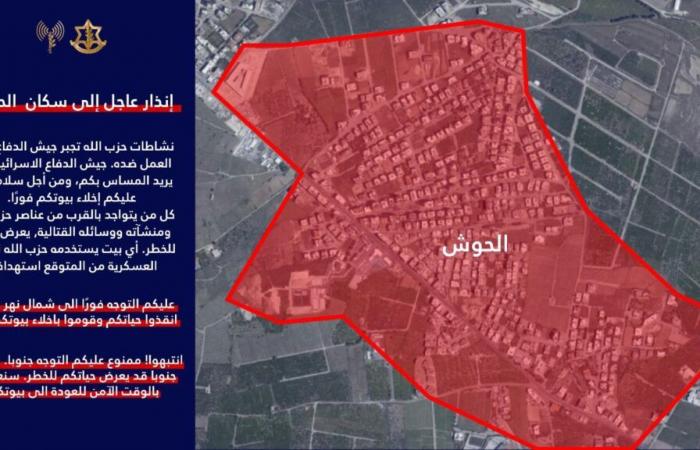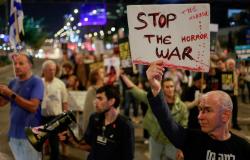– Advertisement –
Avichay Adraee, spokesperson for the Israeli army, issued evacuation orders for the towns of al-Hawsh, Maachouq and Burj al-Shemali, located east of the city of Tyre. According to Adraee, these areas are home to Hezbollah activities. The Israeli army’s warnings were accompanied by maps marking these three locations in red, a color used to designate buildings the army plans to target and destroy.
This threat comes against a backdrop of intensifying Israeli strikes in southern Lebanon. According to the Lebanese Ministry of Health, nine people were killed and six others injured on Wednesday during attacks on towns in the Tire district. These bombings are particularly concentrated on the western sector, notably between Tayr Harfa, Chamaa and Bayyadah, with the apparent objective of isolating Naqoura from Tyre.
The humanitarian and strategic consequences of these operations worry the international community. The explicit threat of destruction of civilian areas, such as al-Hawsh and Maachouq, raises questions about the compliance of Israeli actions with international humanitarian law, particularly with regard to the protection of civilian populations.
Military and strategic context
The Israeli army has intensified its operations in the Tire district, a strategic region close to the Israeli-Lebanese border. This region, which is home to numerous civilian infrastructures and refugee camps, is also considered an area of influence for Hezbollah. Since the start of tensions, localities in the Tire district have been the target of repeated airstrikes.
By targeting al-Hawsh, Maachouq and Burj al-Shemali, Israel appears to want to strike what it describes as “centers of Hezbollah activity.” However, these areas also have a large civilian population, making evacuations even more complex. Local Lebanese authorities denounce these evacuation orders as a strategy aimed at massively displacing populations and further destabilizing the region.
Areas designated in red: a recurring military tactic
The maps distributed by Avichay Adraee show the three localities colored entirely in red. This code is usually used by the Israeli army to indicate buildings intended to be destroyed during strikes. This tactic, often criticized, is seen as a way to legitimize strikes that could include civilian targets.
This strategy has already been used in other areas of Lebanon and the Palestinian territories, where Israel alleges the presence of militants or military equipment in densely populated areas. Human rights organizations warn against the use of such methods, which risk causing mass casualties among civilians.
Operations in the western sector
In addition to the strikes on al-Hawsh, Maachouq and Burj al-Shemali, the Israeli army is carrying out intensive operations in the western sector of the Tire district, between Tayr Harfa, Chamaa and Bayyadah. These localities, located in the immediate vicinity of the border, are strategic for Israel due to their proximity to Naqoura, where the headquarters of the United Nations Interim Force in Lebanon (UNIFIL) is located.
The apparent aim of these strikes is to isolate Naqoura from Tyre, a move that could complicate humanitarian movements and UNIFIL operations. This strategy portends a possible escalation in the region, particularly if Israel decides to engage in a ground offensive.
Local and international reactions
Israeli strikes and threats of destruction of communities in the Tire district have sparked condemnation in Lebanon. The Lebanese Ministry of Foreign Affairs denounced “flagrant violations of international law and the fundamental principles of the protection of civilians”. For its part, Hezbollah warned that any attempt to systematically destroy localities in southern Lebanon would result in a “proportionate and decisive response”.
Internationally, several humanitarian organizations have expressed concern about the intensification of violence in southern Lebanon. The International Committee of the Red Cross (ICRC) has called on all parties to the conflict to respect the laws of war and protect civilian populations. The UN, for its part, has warned of a rapid deterioration of the humanitarian situation in the region.
Southern Lebanon under tension
Since the start of hostilities, Lebanon’s border regions with Israel have become a scene of intensified clashes. These areas, historically marked by tensions between Israel and Hezbollah, are facing a growing humanitarian crisis. Israeli airstrikes, combined with cross-border rocket fire, have forced thousands of civilians to flee their homes.
As the strikes continue, the situation in the Tire district illustrates the challenges posed by this conflict. The threat of destruction of the towns of al-Hawsh, Maachouq and Burj al-Shemali is emblematic of the escalation of violence and the lack of protection of civilians trapped in this war.
– Advertisement –






